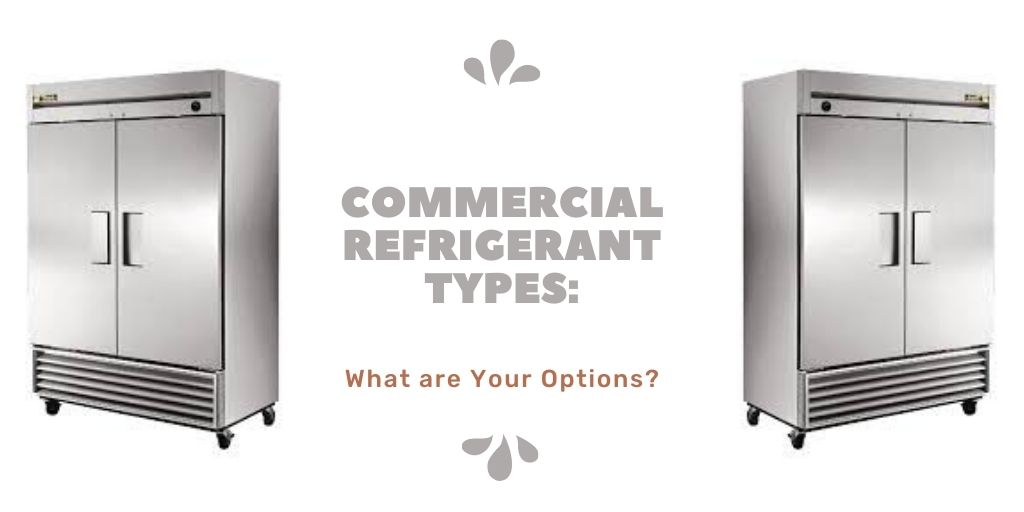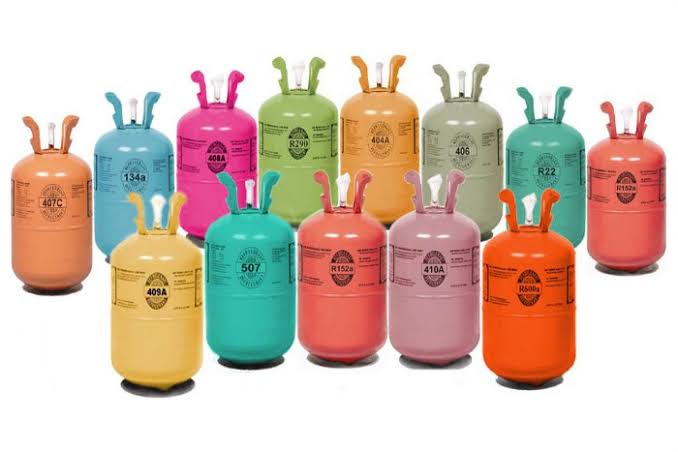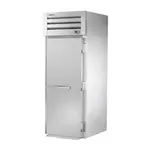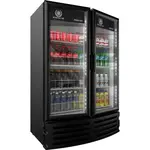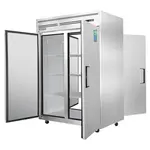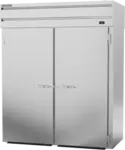What is a Refrigerant?
Refrigerant is the substance that is used throughout the refrigeration cycle. This is most frequently a fluid that undergoes phase changes (goes from liquid to gas and vice versa) to help capture heat within your commercial refrigerator’s chiller cabinet and then release it to help maintain the cabinet’s internal temperature. By removing the excess heat from the chiller cabinet, your refrigerator can maintain the temperature you set at via the thermostat.
How Do Refrigerants Work?
Refrigerants go through quite an amazing journey to maintain your refrigerator’s internal temperature. The refrigerant is only one part of the refrigeration system. This substance moves throughout the system, which is made up of various components, including:
- Expansion Valve
- Condenser
- Compressor
- Evaporator/Evaporator Coils
- The receiver
Throughout the refrigeration cycle, the refrigerant will move through these various components, often being compressed along the way, transforming it from a liquid substance to a gaseous one. It’s in this gaseous state that it’s able to absorb any heat in your chiller cabinet and then filter it out, allowing your refrigerator and all of its components to remain at the proper storage temperature.
Important Terms You’ll Want to Know
If you’re looking to choose a commercial refrigerant type that is kinder to the planet, then you need to be familiar with these two terms, as you’ll be seeing them quite a bit:
- Global Warming Potential (GWP): Refers to the potential of an appliance to emit greenhouse gasses that can contribute to global warming. It is used as a measurement unit to inform individuals just how high of a risk an appliance may be when it comes to greenhouse gas emissions. The lower the GWP, the more eco-friendly the refrigerant is.
- Ozone Depletion Potential (ODP): The contribution of compounds to ozone depletion. The lower the number, the less contribution, which is better for the environment.
12 Commercial Refrigerant Types Worth Exploring
When it comes time to invest in a new refrigerator, it’s essential that you stay up to date on all the latest technology and trends, including the latest on commercial refrigerants that you may come into contact with. Here are 12 commercial refrigerant types that you may come across during your research:
1. R-12 Refrigerant
R-12 refrigerant is a chlorofluorocarbon- (CFC) and methane-based refrigerant that was frequently used in both commercial refrigerators and air conditioners. However, due to its ozone depletion and global warming potential, it has since been banned from any modern appliances.
- Banned: Yes, in 1994
- Eco-Friendly: No
- Flammable: No
- Global Warming Potential: 10,900 – High
- Ozone Depletion Potential: 1.0
2. R-22 Refrigerant
R-22 refrigerant is a hydrochlorofluorocarbon (HCFC) and contains less chlorine than CFCs. It’s still found in some older refrigerators and air conditioners, although no new appliances are allowed to utilize this refrigerant as it’s considered harmful to the environment. In fact, it’s currently being phased out and will be completely banned by 2030.
- Banned: Will be banned by 2030
- Eco-Friendly: No
- Flammable: No
- Global Warming Potential: 1,810 – Medium
- Ozone Depletion Potential: 0.055
3. R-134a Refrigerant
R-134a is a hydrofluorocarbon (HFC) refrigerant that is often used in both refrigerators and car air conditioning units. Since it lacks any ozone depletion potential, it’s considered a more eco-friendly refrigerant.
- Banned: No
- Eco-Friendly: Somewhat
- Flammable: No
- Global Warming Potential: 1,430 – Medium
- Ozone Depletion Potential: 0
4. R-290 Refrigerant
R-290 is a hydrocarbon- (HC) and propane-based refrigerant used in both refrigerators and air conditioners. Thanks to its low global warming and ozone depletion potential, it’s considered more eco-friendly than other refrigerants.
- Banned: No
- Eco-Friendly: Yes
- Flammable: Yes
- Global Warming Potential: 6 – Low
- Ozone Depletion Potential: 0
5. R-401A Refrigerant
R-401A is an HFC refrigerant that is utilized in both refrigerators and air conditioners. While it has a medium global warming potential, it has a lower ozone depletion potential, making it more eco-friendly than some available alternatives.
- Banned: No
- Eco-Friendly: Somewhat
- Flammable: No
- Global Warming Potential: 1,182 – Medium
- Ozone Depletion Potential: 0.037
6. R-402A Refrigerant
R-402A is an HCFC refrigerant that is utilized in low- and medium-temperature refrigerators. While it has a lower ozone depletion potential, it has a higher global warming potential, making it less desirable than some other refrigerant options available.
- Banned: No
- Eco-Friendly: Somewhat
- Flammable: No
- Global Warming Potential: 2,746 – High
- Ozone Depletion Potential: 0.019
7. R-402B Refrigerant
R-402B is another HCFC refrigerant that is utilized in both low- and medium-temperature refrigerators. While it has a lower global warming potential than R-402A, it has a slightly higher ozone depletion potential.
- Banned: No
- Eco-Friendly: Somewhat
- Flammable: No
- Global Warming Potential: 2,379 – Medium
- Ozone Depletion Potential: 0.03
8. R-404A Refrigerant
R-404A is an HFC refrigerant that is used in both freezers and refrigerators. While it has a low ozone depletion potential, it has an extremely high global warming potential, making it a non-eco-friendly option.
- Banned: No
- Eco-Friendly: No
- Flammable: No
- Global Warming Potential: 3,922 – High
- Ozone Depletion Potential: 0
9. R-409A Refrigerant
R-409A is another example of an HCFC that is considered somewhat eco-friendly thanks to its low ozone depletion potential and average global warming potential. However, it’s most frequently utilized in medium-temperature refrigeration units.
- Banned: No
- Eco-Friendly: Somewhat
- Flammable: No
- Global Warming Potential: 1,558 – Medium
- Ozone Depletion Potential: 0.047
10. R-410A Refrigerant
R-410A is an HFC refrigerant that is slowly being phased out of use due to its higher global warming potential. In fact, it will no longer be acceptable for use in newly build refrigerators or air conditioners beginning January of 2021.
- Banned: Will no longer be acceptable for use in new equipment as of January 1, 2021
- Eco-Friendly: Somewhat
- Flammable: No
- Global Warming Potential: 2,090 – Medium
- Ozone Depletion Potential: 0
11. R-427A
R-427A is another HFC that is only considered somewhat eco-friendly thanks to its medium global warming potential. It’s most frequently used in commercial refrigerators and air conditioners.
- Banned: No
- Eco-Friendly: Somewhat
- Flammable: No
- Global Warming Potential: 2,140 – Medium
- Ozone Depletion Potential: 0
12. R-450A Refrigerant
R-450A is a hydrofluoroolefin (HFO) refrigerant that is considered much more eco-friendly than other refrigerants used in refrigerators and car air conditioning units thanks to its extremely low ozone depletion and global warming potential.
- Banned: No
- Eco-Friendly: Yes
- Flammable: No
- Global Warming Potential: 601 – Medium
- Ozone Depletion Potential: 0
How Much Attention Should You Be Paying to Commercial Refrigerant Types?
Again, many people pay little attention to the commercial refrigerant types utilized in their appliances. This is especially true since manufacturers are responsible for following the necessary EPA guidelines for creating eco-friendly appliances – not the consumer.
However, if you’re trying to brand yourself as a sustainable, eco-friendly business, you may want to put the extra time into learning about the refrigerant used in your appliances. Even if you aren’t looking to broadcast your sustainability efforts, deciding to use a more eco-friendly refrigerant makes you a part of the global warming solution.

